095. Welcome to Windows 7, Everyone
I can see clearly now the rain is gone/I can see all obstacles in my way/Gone are the dark clouds that had me blind/It’s gonna be a bright (bright)/Bright (bright) sunshiny day/ — Johnny Nash, 1972
While it is incredibly fun to do a first demo of a big product as described in the previous section, there is something that tops that and even tops the actual release to manufacturing. That is providing the release, actual running code, to a product’s biggest fans. It was time to welcome everyone to Windows 7 and put the code that the team had been working on since the summer of 2007 out for the world (of techies) to experience.
Back to 094. First Public Windows 7 Demo
Seattle summers are notoriously difficult on product development. After a long spell of clouds and rains, the beauty and long days of Pacific Northwest summers arrive, neither are particularly conducive to coding.
Summer wasn’t why I ended up here, but it certainly had an impact on me. On my first visit in 1989 during a dismal February, I saw the outdoor Marymoor Velodrome down the street from Microsoft and thought, this is going to be great. On TV it didn’t look as difficult to ride as I eventually learned it was. I sort of rode it exactly one time and that was the day my bicycle arrived from Massachusetts.
But alas, product development demands don’t end even with 15 hours of daylight.
It was going to get busy for the Windows 7 team. Our planned schedule called for the third development milestone to be complete by the end of summer 2008.
We were making progress, but the schedule was slipping. The code was getting better every week, but the overall game of schedule chicken that often plagued a large project was an historical concern. This was our first time as a new team going through this part of a product cycle. While we had a good deal of positive progress building a team culture, Windows was notorious for groups betting against each other’s schedules and being less than forthright with their own.
When HeikkiK was running the Office 95 ship room, he declared that everyone should be working to finish first, not simply to finish second to last. We needed to get to the end of the milestone as a team working together without looking for one group to blame, since it is never one group. JonDe and I had this same concern.
Everyone spent the summer installing daily builds on every PC we could. At one point, I must have had eight different PCs between home and office and was installing on all of them nearly every day. Every night I was installing a new build at home while doing email and other routine tasks. Even though my home “service level agreement” called for no beta software, an exception was made for Windows 7.
I was working at two performance extremes. I went to Fry’s Electronics and built my own “gamer” PC from the best components. I spent big bucks on a newfangled solid-state desktop drive (not common at the time), a crazy graphics card, fast memory, and the most ridiculous Intel chip available. I installed Windows 7. I was blown away by the speed (as well as the noise and wind emanating from the mini-tower). Starting Word or Excel seemed instantaneous. Boot took low single-digit seconds. It reminded me of the first time I used a hard drive on my father’s Osborne computer and how much faster it was compared to floppy disks. I used this PC when I sat at my desk at work, which wasn’t often as I was always walking around the halls.
At the other end of the spectrum were Netbooks. To the degree I could, I had taken a fancy to the Lenovo Netbook, the IdeaPad S10, and carried it with me everywhere especially at my favorite breakfast place (Planet Java) or lunch place (Kidd Valley) where I did a lot of Windows 7 blogging. Every Netbook was close to identical on the inside, but the Lenovo had a good screen and a rugged exterior. I modified mine, replacing the spinning hard drive with a then non-economic solid-state drive to better emulate future laptops like the MacBook Air. It was my primary PC for writing blogs posts, email, spreadsheets, and browsing, and the like, which was most of what I was doing. When we finally got to the Professional Developers Conference, this was the PC I held up with a bright yellow “I’m a PC” sticker on it, stickers marketing created in a jiu-jitsu move embracing the blowback from the Apple TV commercials.
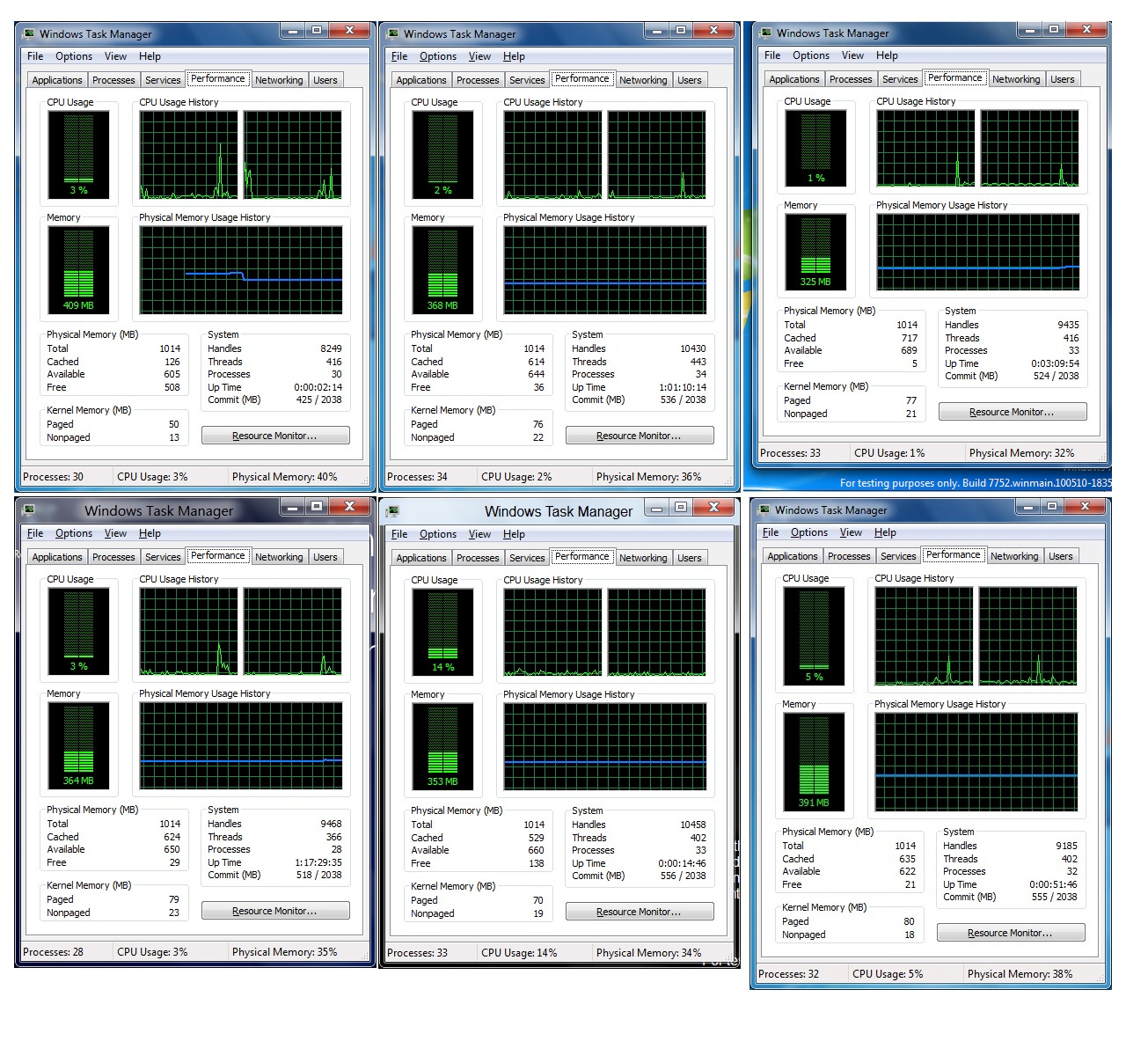
I was constantly on the lookout for memory consumption and the number of running processes, the signs of bloat in Vista—fewer processes and less memory were better. Each process was a critical part of Windows. The number of processes had soared with Vista, and each had overhead in complexity and performance (in contrast to Linux, Windows processes were much more substantial and important to track.) Windows 7 was making impressive strides in reducing memory usage and process complexity. It served to make me feel connected to the engineering of Windows 7 and reminded me of counting bytes and seconds back in the day. I snapped screen shots of the Windows Task Manager and would bug JonDe and AlesH every couple of days.
Each day booting into a new build and seeing the progress was a great day. Each day revealed a crisis or challenge, but as a team everything continued to move forward.
Even though I was mostly an observer, the effort to improve performance was some of the best work of the release. It set a tone for making progress, but also for the ability of teams to work together. The conventional wisdom was that Windows Vista was inevitable and unavoidable as capabilities were added and the product grew which could not have been prevented. Windows 7 disproved that theory.
By midsummer, we had to slip the schedule based on our progress through M2 and M3. Originally our goal was to finish M3 and have a full beta in time for the previously scheduled Professional Developers Conference, PDC, in Los Angeles. We weren’t where we needed to be, so we took about an eight-week slip. The build at the PDC would officially be pre-beta, terminology we just made up. This would be our last slip. JonDe and I were privately relieved at the degree of the slip, but frankly the team was excited to be clearly on track, relatively, for the first time in many years. Depending on your experience or the context, eight weeks can seem huge or literally nothing. It was nothing.
SteveB sent a memo to all of Microsoft outlining some of the work to date for the whole of the fiscal year. The company had made a lot of progress on many fronts. The topic that had occupied a great deal of discussion, and was a good portion of his memo, was Google and competing with it on the consumer front and the potential relationship with Yahoo. SteveB also described the emerging cloud strategy, and the fact that more would be shared on that topic at our upcoming PDC.
Fiscal year 2008 was quite a year for Microsoft. Revenue broke $60 billion and operating profit grew 21 percent to $22.5 billion. The numbers were incredible. Still, the concerns about the PC and catching up on consumer services dominated Wall Street’s view. This memo was one of the early communications in a strategic shift to the cloud platform and you can feel the push-pull between cloud and the traditional model in the technology descriptions. It’s important to say that it was still super early in the journey to the cloud for enterprise computing and the topic was not top of mind for customers, especially as the financial crisis began to take hold. In fact, the feeling that the cloud was architecturally inferior to private data centers was by far the most common customer belief. Their future enterprise computing model was a data center running servers using virtualization. In 2008, the idea that there would be something of a new cloud operating system was mostly a view held inside the halls of Google.
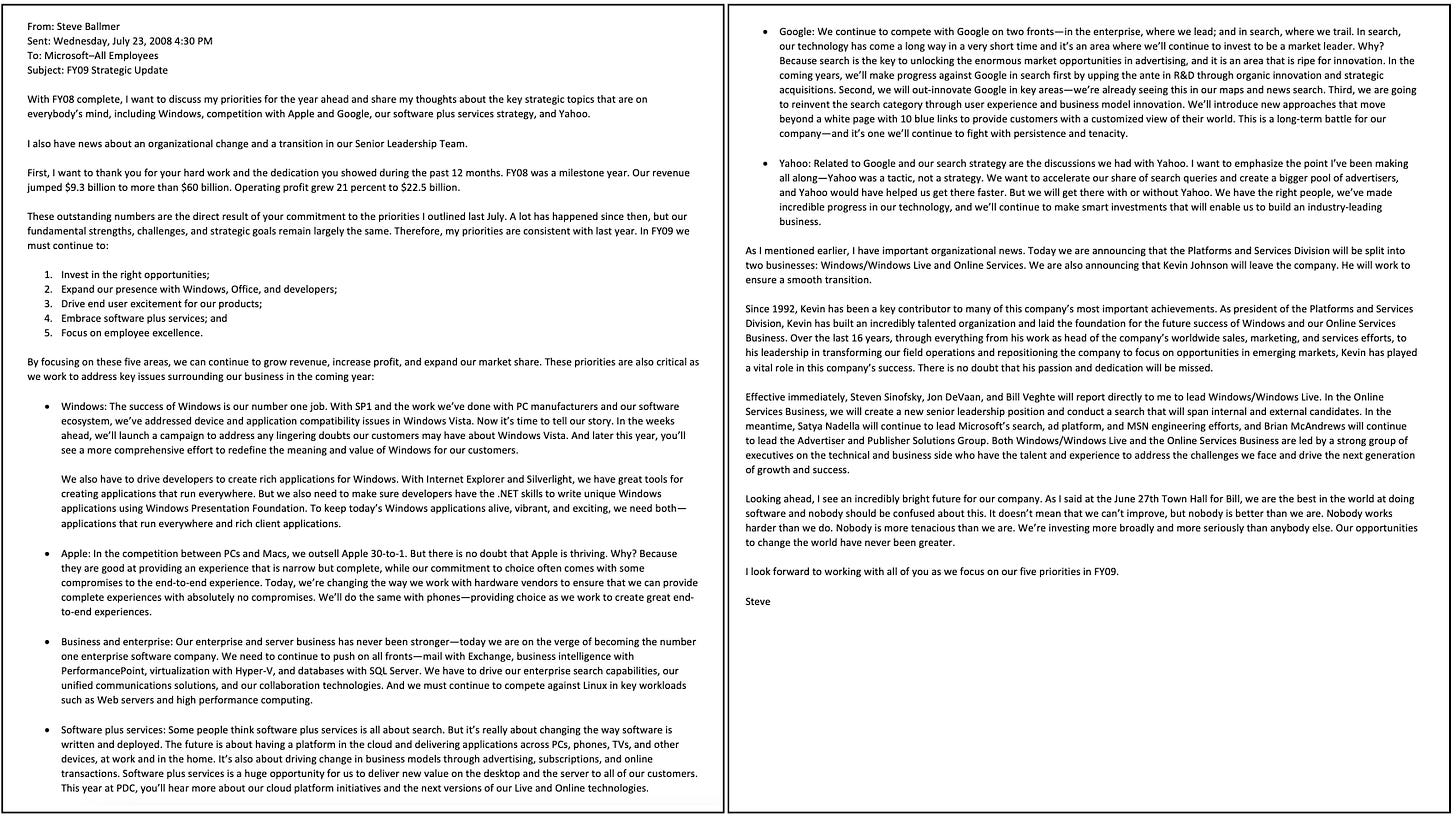
In the memo, SteveB announced that KevinJo was leaving to be CEO of Juniper Networks, and that JonDe and I, along with Bill Veghte (BillV) leading marketing, would report directly to Steve, a reporting structure that remained in place through the release without issue. This was a standard and expeditious way to handle a managerial change at this stage of a big product. Incidentally, Satya Nadella (SatyaN) had recently moved to manage Search and ads in March 2007 and would also report to SteveB in a similar move.
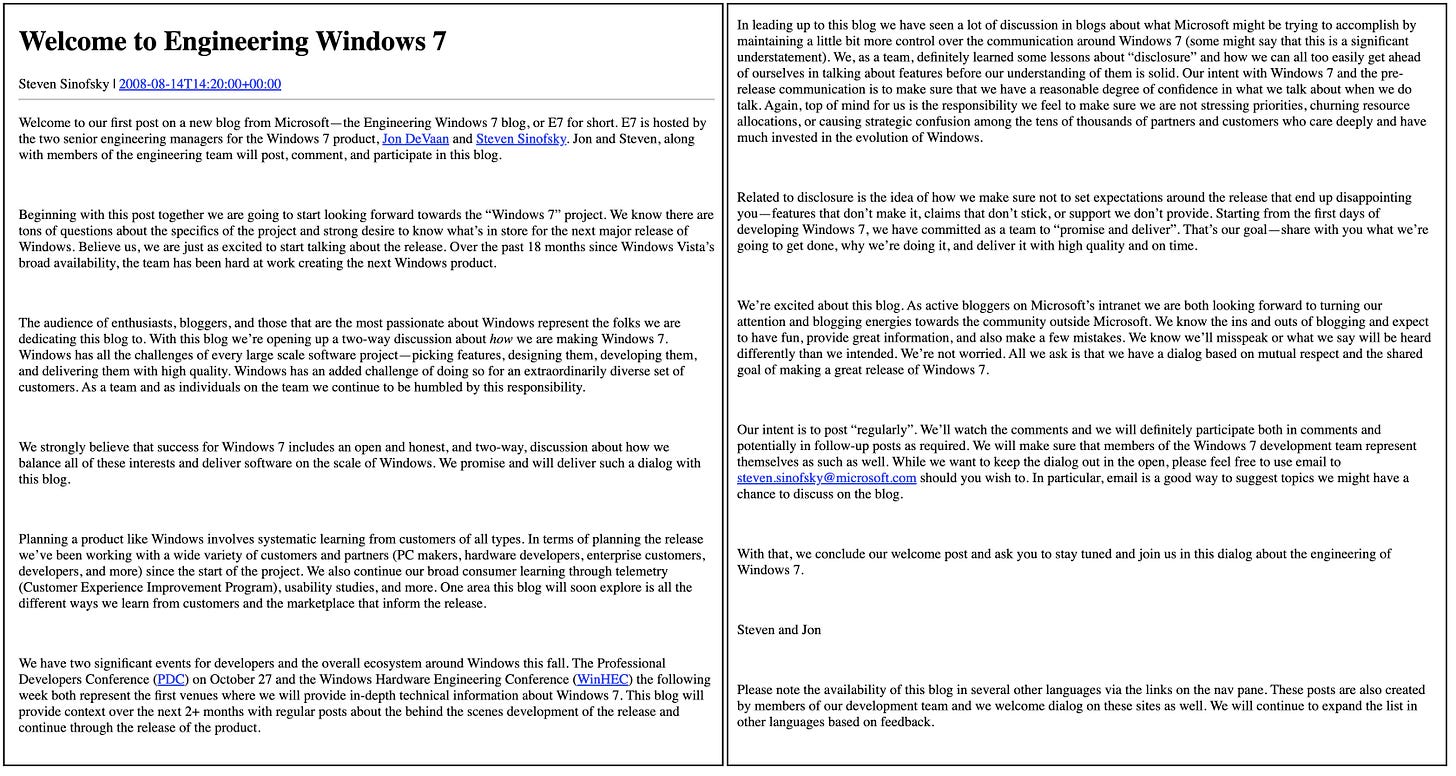
In the lead-up to the PDC we began blogging publicly about Windows 7. With the focus on tech enthusiasts, IT professionals, and the trade press, I created a blog called Engineering Windows 7, or e7. An extension of how we thought about blogging for Office 2007, the blogs were the primary first-party communication channel for the product. We authored long and detailed posts, thousands of words, about the implementation choices we were making and how we measured progress. We offered tons of data to describe real-world Windows use (often my favorites posts). I authored posts but also introduced posts that other team members wrote, each expressing the design point of view and rationale. Many generated a great deal of dialogue and discussion and became news stories themselves. There wasn’t really a Hacker News yet for Windows coverage, but the comments sections of many stories read just like Hacker News would have read. Tech enthusiasts loved to dispute the data provided then just as today.
While to some press the blogging came across as a carefully crafted corporate message, nothing was further from the truth. We were simply blogging. The posts did not go through any corporate machinery or apparatus. They were as authentic as they could be. And the tradition worked so well that after the PDC it became a significant part of the communication of Windows going forward.
There were two relevant industry announcements that at any other time would have caused a great deal of distraction. The PC world was entirely focused on the PC, to the exclusion of the world of mobile phones, and, to some degree, browsers were still distinct as a challenge to Windows because they still ran on Windows and had yet to incorporate much beyond rendering text and graphics. Yet both phones and browsers would have announcements that would radically alter the competitive landscape for Windows 7.
In June 2008 at Apple’s WWDC (the World Wide Developer Conference, Apple’s version of the PDC), Apple announced the much-anticipated and predicted iPhone SDK and App Store which was teased earlier in the year. Initially, it had 500 apps, small relative to PC apps, but that number would grow at an astronomical rate. More importantly, it solved many key problems that had plagued PCs. In the announcement, which was a short note from Steve Jobs posted to Apple’s news site, he said “We’re trying to do two diametrically opposed things at once—provide an advanced and open platform to developers while at the same time protect iPhone users from viruses, malware, privacy attacks, etc.” This controversial change riled tech enthusiasts but also ushered in a new definition of computer, one that was safer and more reliable than anything a PC (or Mac) could offer.1 The emphasis below is mine.
Third Party Applications on the iPhone
Let me just say it: We want native third party applications on the iPhone, and we plan to have an SDK in developers’ hands in February [2008]. We are excited about creating a vibrant third party developer community around the iPhone and enabling hundreds of new applications for our users. With our revolutionary multi-touch interface, powerful hardware and advanced software architecture, we believe we have created the best mobile platform ever for developers.
It will take until February to release an SDK because we’re trying to do two diametrically opposed things at once – provide an advanced and open platform to developers while at the same time protect iPhone users from viruses, malware, privacy attacks, etc. This is no easy task. Some claim that viruses and malware are not a problem on mobile phones – this is simply not true. There have been serious viruses on other mobile phones already, including some that silently spread from phone to phone over the cell network. As our phones become more powerful, these malicious programs will become more dangerous. And since the iPhone is the most advanced phone ever, it will be a highly visible target.
Some companies are already taking action. Nokia, for example, is not allowing any applications to be loaded onto some of their newest phones unless they have a digital signature that can be traced back to a known developer. While this makes such a phone less than “totally open,” we believe it is a step in the right direction. We are working on an advanced system which will offer developers broad access to natively program the iPhone’s amazing software platform while at the same time protecting users from malicious programs.
We think a few months of patience now will be rewarded by many years of great third party applications running on safe and reliable iPhones.
Steve
P.S.: The SDK will also allow developers to create applications for iPod touch. [Oct 17, 2007]2
The App Store also provided distribution and awareness to developers, a way to make money, and a way for Apple to vet apps that might be harmful to consumers. At the time the focus was on the fact that “30 percent goes to Apple.” When we saw the store, though, we knew the change would be monumental. To find software for a PC, the best someone could have hoped for was a website such as download.com. There existed varying levels of trialware, freeware, spyware, and malware. Apple had solved the software distribution problem, made sure software was reasonably safe and high quality, and given ISVs a huge new avenue for creativity and money. All on the most exciting computer around, the iPhone. That was the bad news. The good news was that the world still viewed PCs and phones as totally different things.
The world other than Steve Jobs and Apple, as discussed in the previous section. History would later reveal through email discovery the internal conflict that surrounded opening the iPhone to developers so broadly. The success would also go far beyond even what Steve Jobs anticipated.
All that I could think was, Time. I need more time
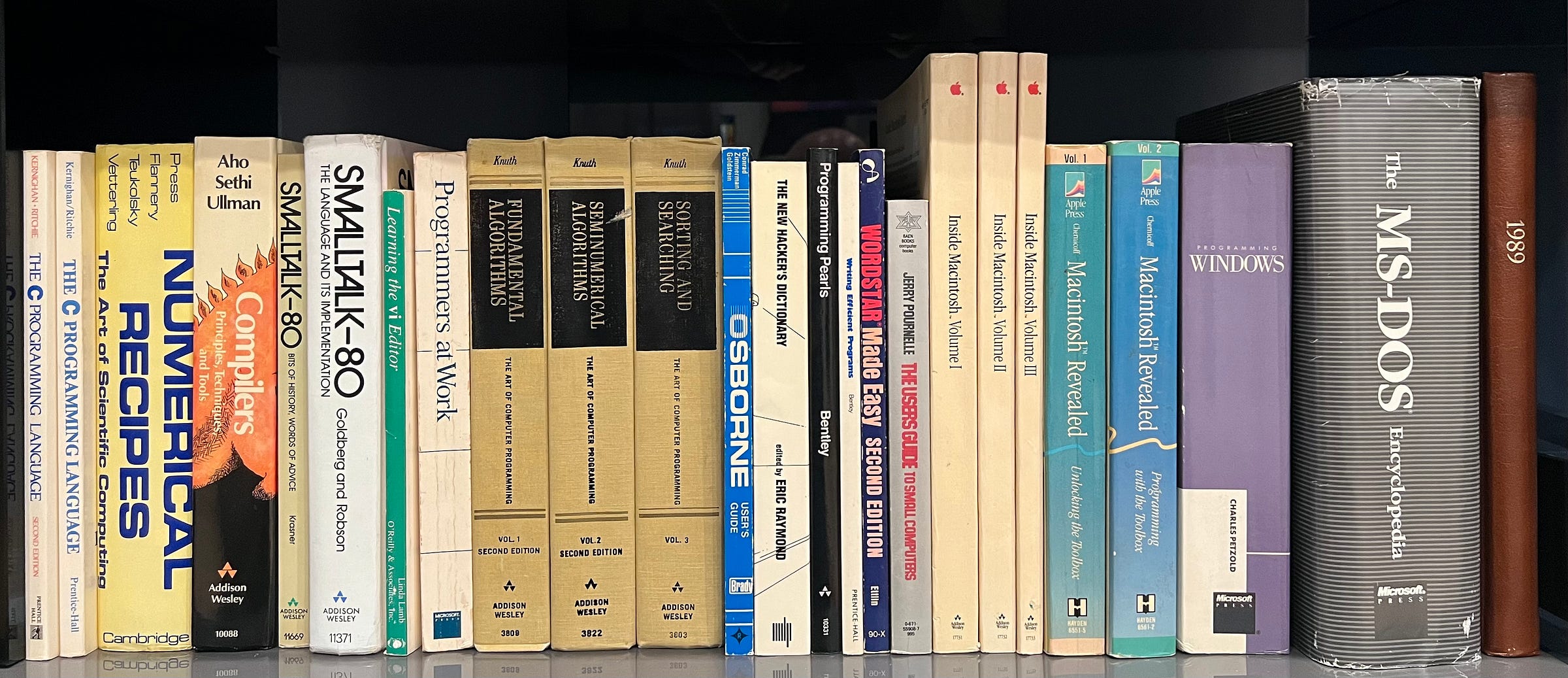
That was not all I thought. I also greatly admired what Apple was accomplishing. Like many who joined the Apps division in the 1980s, Macintosh was a crucial part of my early Microsoft work and the years before that. The old Mac ToolBox APIs are forever imprinted in my memories. Other than the die-hard fans, few generally acknowledged the consistent refinement and foresight in Apple’s software design. Several of us on the team were “original” Mac third-party developers from the mid-1980s and had always admired not only the results but the patience of their process. The continuous iteration and complete execution of what they did was admirable. Apple’s business in Macs was definitely not something we worried about, but their product execution was worrisome. I looked over their R&D spend and compared it to Windows and Office. In 2008, Apple for the first time eclipsed $1 billion in R&D for the year, a big uptick from the prior year, perhaps an indication of iPhone and iCloud ramp. The full Windows 7 team was spending about the same. There’s a huge difference in R&D when it comes to having a full ecosystem but at the same time R&D for hardware is much more expensive. The main point is not only were they building breakthrough products, they were doing so remarkably efficiently compared to Microsoft.
The Mac might have been a better product, but Windows won, and the winning product becomes the better product in the market. It was not until the iPhone and SDK came to be that the true appreciation of all they had done with so relatively little was so broadly understood.
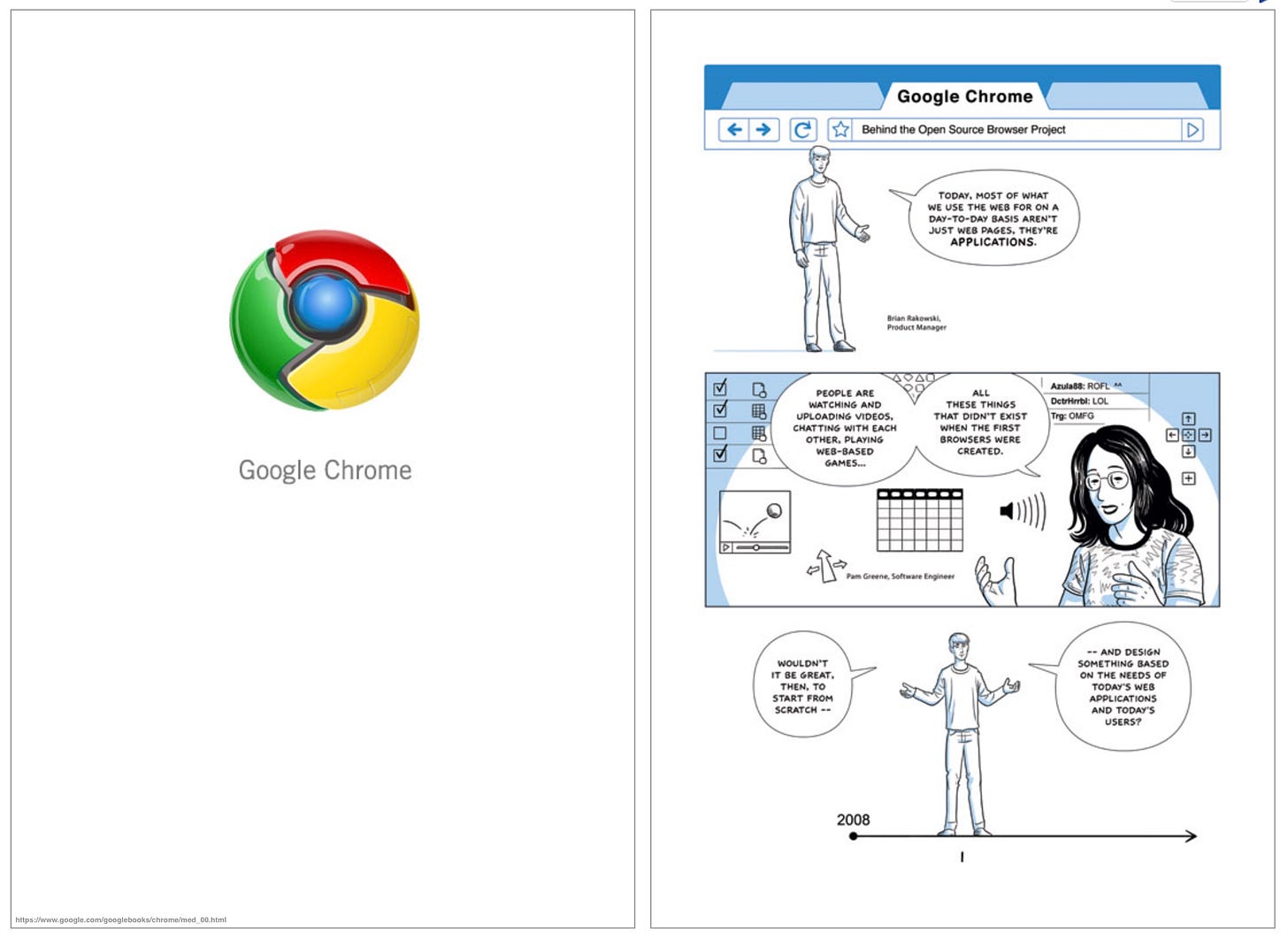
A more shocking announcement that hit closer to home came six weeks later. Google announced the Chrome browser with a blog post and a classically Googley online comic that accidentally dropped too soon. Chrome, ironically named due of the absence of user interface chrome, would prove to be monumentally disruptive to the browser world. Google had dramatically improved performance and security in browsing compared to IE 7 from Vista (or IE 6 that so many were running still) and current leader Firefox. They had committed to open source and brought an entirely new level of energy to the browser battle. In his blog post, Sundar Pichai (yes, then product manager for Chrome) wrote in a nod to antitrust that the “web gets better with more options and innovation. Google Chrome is another option, and we hope it contributes to making the web even better.”3 In some ways, we were straight back to 1996 again. This would be a huge problem for the newly reconstituted Internet Explorer team, both immediately and going forward. Within a short time, there was a massive share shift to Chrome. Much like Gmail, Google released a product, seemingly out of nowhere, into what was viewed as a stable space. And they took it over. It would be years before privacy, tracking, and all the “evil” stuff Google’s browser would come to be, but at the time, a new competitive landscape was defined for IE. If our job was difficult before, it suddenly was even more so.
The PDC took place on October 27th at the Los Angeles Convention Center. Azure, the new name for Red Dog, was announced on the day one keynote. That proved to be both prescient and somewhat ahead of the curve for most attendees. Windows 7 was the second-day keynote and carried the bulk of the news for the show. In some ways the fact that most of the attendees did not seem to find Azure immediately useful made our jobs easier. Most attendees were still debating the proper way to pronounce Azure. The developer relations leader found the debate the night before particularly irksome as he was a Persian who had his own ideas of how to pronounce a word he claimed as native in origin. I was completely entertained by this late-night sideshow. Nevertheless, the fact that the attendees were somewhat puzzled by Azure compared to what they saw as vastly more interesting sessions on .NET, Avalon, virtualization, or the Windows 7 desktop. The disconnect was a harbinger of the disruption challenges the entrenched Microsoft would face.

While the audience for the PDC was professional developers there to learn the latest in APIs, tools, and techniques from Microsoft, the front rows of the main hall were the all-too-familiar members of the press. Looking out from the stage, I could see all the stalwarts of Microsoft beat reporters and technology press who had been frustrated by the lack of information of Windows 7. We were doing a keynote for developers who spent a few thousand dollars to be at the show, but in reality we were putting on a show that needed to be understood by the mainstream media and conveyed through the expertise of the industry press.
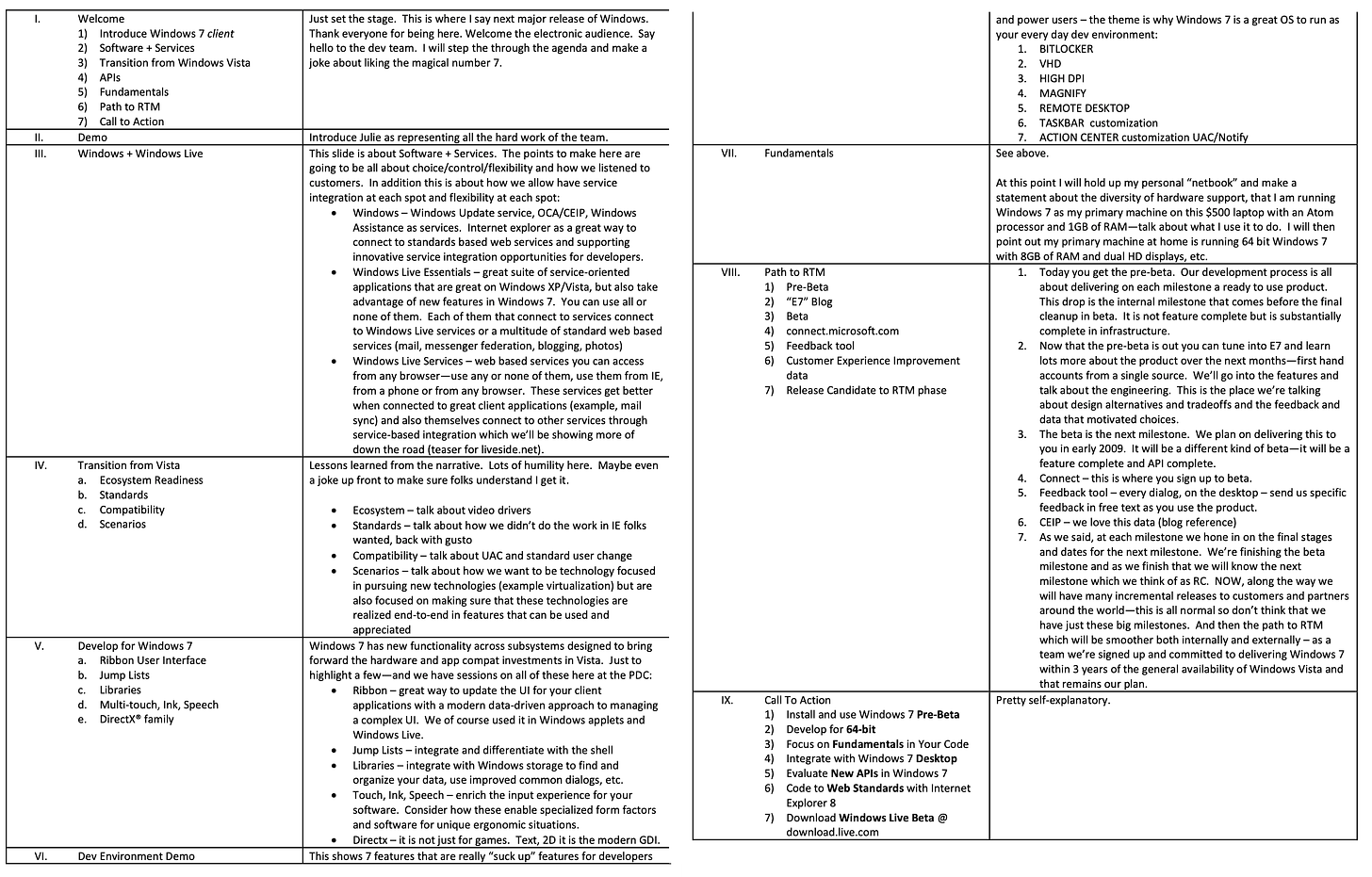
Steve Jobs had upped the stakes with his spectacular keynotes, increasing pressure across the industry to put on a good show. The normal Microsoft keynotes, the kind pioneered by BillG, were long and detailed with complex architecture slides and many graphics. These were somewhat enhanced as we moved to enterprise computing with obligatory and infamous “partner videos” featuring senior IT professionals in front of architectural diagrams or racks of equipment extolling the virtues of Microsoft’s strategy. The audience expected this type of keynote and expected us to write code on stage. By those measures, they keynote might disappoint.
While we tried to streamline the keynote, marketing insisted on having at least one customer testimonial. This is a pretty cool demo of work by Autodesk showing off the use of touch in Windows 7. (Source: Microsoft)
Having said that, as we planned for my first keynote leading Windows, I knew that the biggest mistake I could have made would have been to try to emulate what I was not. Most importantly, I also had to find a way to apologize for Vista without throwing the product or team under the bus. I had to find a way to be excited about Windows 7, realizing we had holiday PCs with Vista still to sell. Above all, our announcement was for a pre-beta, not even an official beta, though it was ultimately a distinction without a difference.
For my part, I went with who I was—like Sammy Davis Jr. used to say, “I’ve gotta be me.” The slides I showed were sparse and my words carefully chosen. While not one for grand entrances, I did choose “I Can See Clearly Now” by Johnny Nash as walk-on music. I was the only thing standing between the thousands of press and attendees, and seeing Windows 7 code. We knew people were there to see a demo, not a build-up or a long story. Just get to the clicks. I used just two minutes and not even 400 words then introduced JulieLar to step on stage and start clicking. I stepped down from the podium and remained upstage opposite Julie.
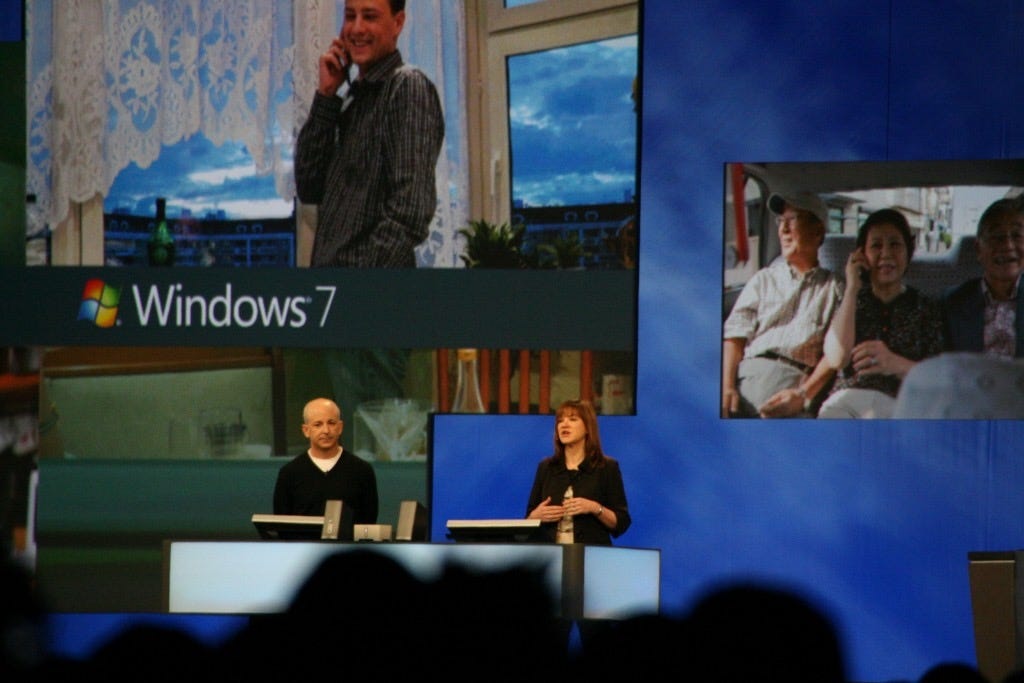
As soon as she brought up the screen on the monitor, people started taking pictures, some with their new iPhones, but most with Windows Mobile, and since they were live-blogging the event, we knew they were noting the build number that was visible at the bottom of the screen, confirming that our debate about what version of Windows we were working on would be part of the conversation. Within about a minute Julie got her first round of spontaneous applause and hoots. The demo was fantastic and every time she said “…works the way you want to,” we could feel the excitement. She demonstrated all features with both a mouse and by using touch on a monitor, including showing an on-screen keyboard with predictive text and more. The bulk of the demonstration emphasized “putting you in control” of Windows.
Once she was finished, I stepped onto the center of the stage and got to say, on behalf of the entire team, something two years in the making.
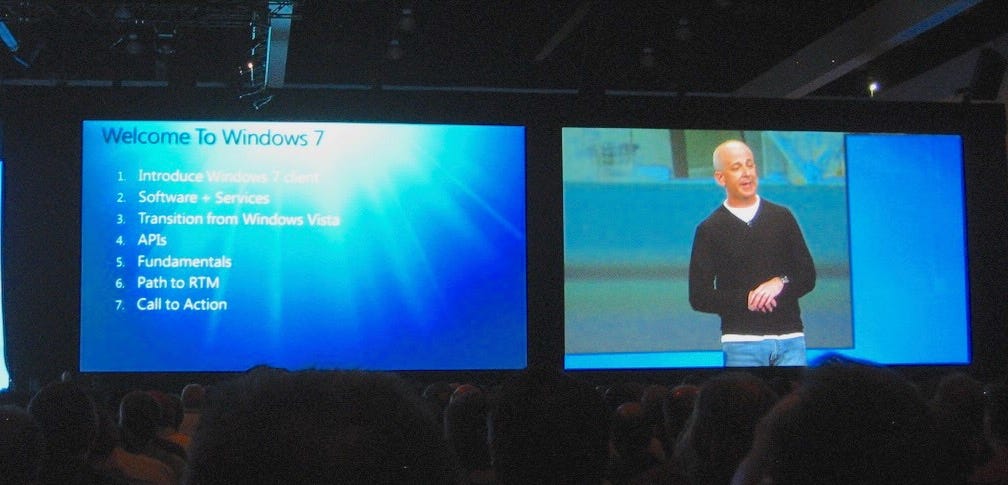
“Welcome to Windows 7, everyone.”
It was the perfect demo to introduce the product.
At some point in the keynote I needed address what everyone was waiting for which was what did Microsoft really think about Vista. While the press would no doubt take note, the credibility of what was said would rely on winning over the tech enthusiasts. More than any audience, the tech enthusiasts in the room were most disappointed in Vista and felt let down by the product. From March 2006 when I came to Windows, I promised to never be critical of what preceded me and I intended for that to be the case. It would have been so easy and so cathartic for the room to profusely apologize for Vista. It would have been equally wrong to pretend that we had not made some sort of mistake. I chose a path of subtlety and to acknowledge “feedback” in all its forms, including a few television commercials. With a slide titled “Transition from Windows Vista” I framed the work we had done since Vista released as providing context for the day’s keynote:
As we set out to build this release of Windows, we really did have to recognize the context with which we were releasing Windows 7 and developing it. And that’s in transitioning from Windows Vista. We certainly got a lot of feedback about Windows Vista at RTM. (Laughter.) We got feedback from reviews, from the press, a few bloggers here and there. Oh, and some commercials. (Laughter.)4
As part of the session, we wanted to highlight some of the features that were specifically relevant to the developer and enthusiast crowd. I took a moment to show seven features (the number 7 was used a lot) that were chosen specifically to generate applause for the crowd including: 1. BitLocker disk encryption (previously in Vista Ultimate), 2. Mounting VHD (a virtualization feature), 3. High DPI (support for really big monitors and normal sized text), 4. Magnify (an assistive technology for low vision that is also useful for product demonstrations), 5. Remote Desktop across dual monitors (the first live dual monitor demo we ever did), 6. Taskbar Customization (anything with customization is a pleaser), 7. Action Center Customization UAC/Notifications (the improvements over Vista for enthusiasts).
There was a clear call-to-action for developers including moving to 64-bits, using Windows touch, and more, but mostly to download and install Windows 7 pre-beta. People were doing that as soon as the lights faded.
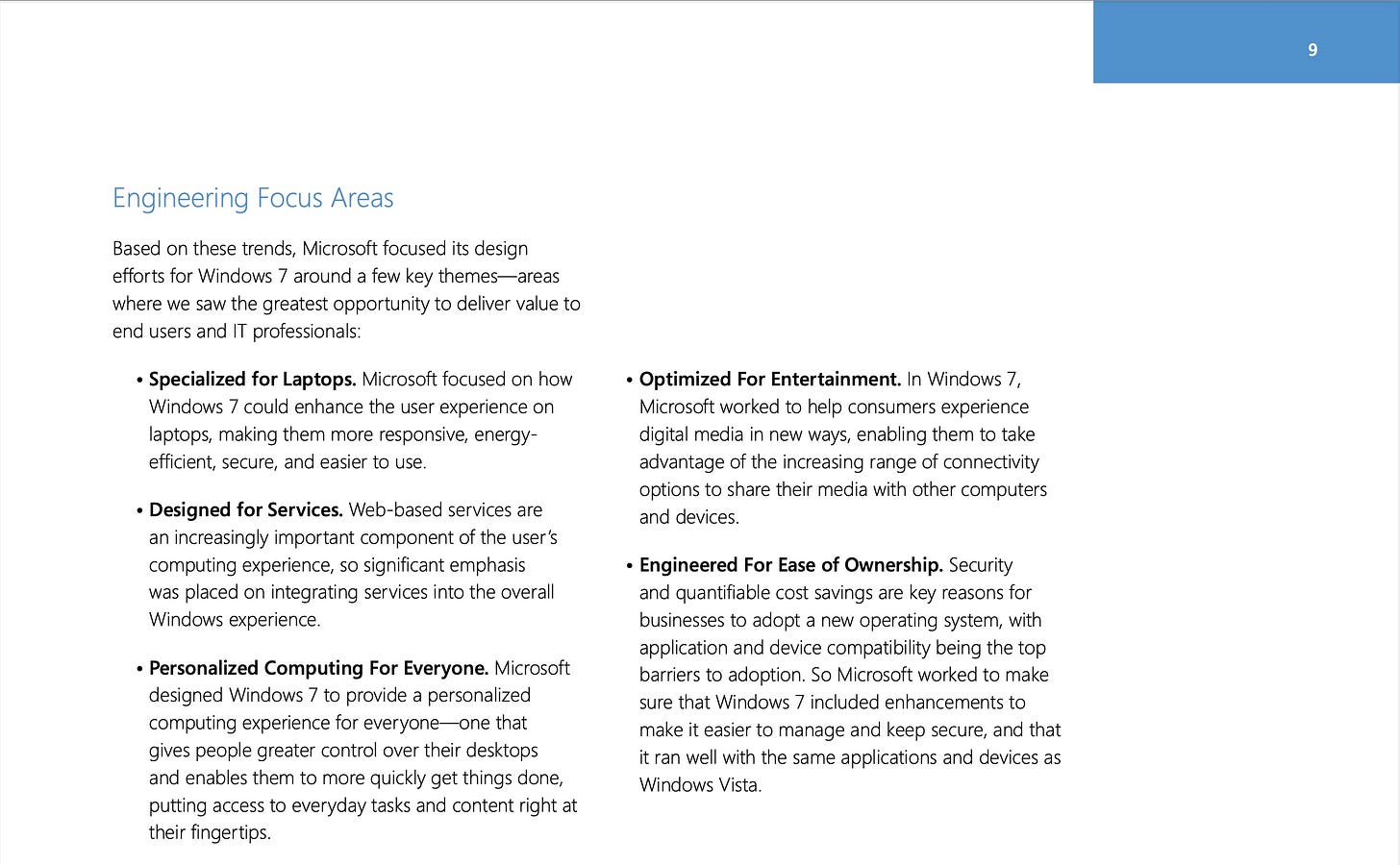
We wanted the keynote to be easy and approachable, not usually the norm at the PDC. That also meant we would leave out a good deal of the team’s work and new features present in the beta build. To that end we created a massive “Product Guide” for the trade press. We would also follow that up with a workshop for them to attend where they would have a chance to ask questions directly of the product leaders. The full product guide ran 119 pages! The team promised and delivered, and you can see this from the prominence of the “Engineering Focus Areas” in the guide which were taken straight from the product vision and mock press release.
While we would not normally expect long-form reviews and deep dives in a pre-beta, Windows 7 was generating so much interest that the tech press was filing tons of stories as were individual bloggers who drilled into every aspect of change from Vista. YouTube was filled with demos created in short order. Windows 7 was the top of Techmeme, and not for messing up.
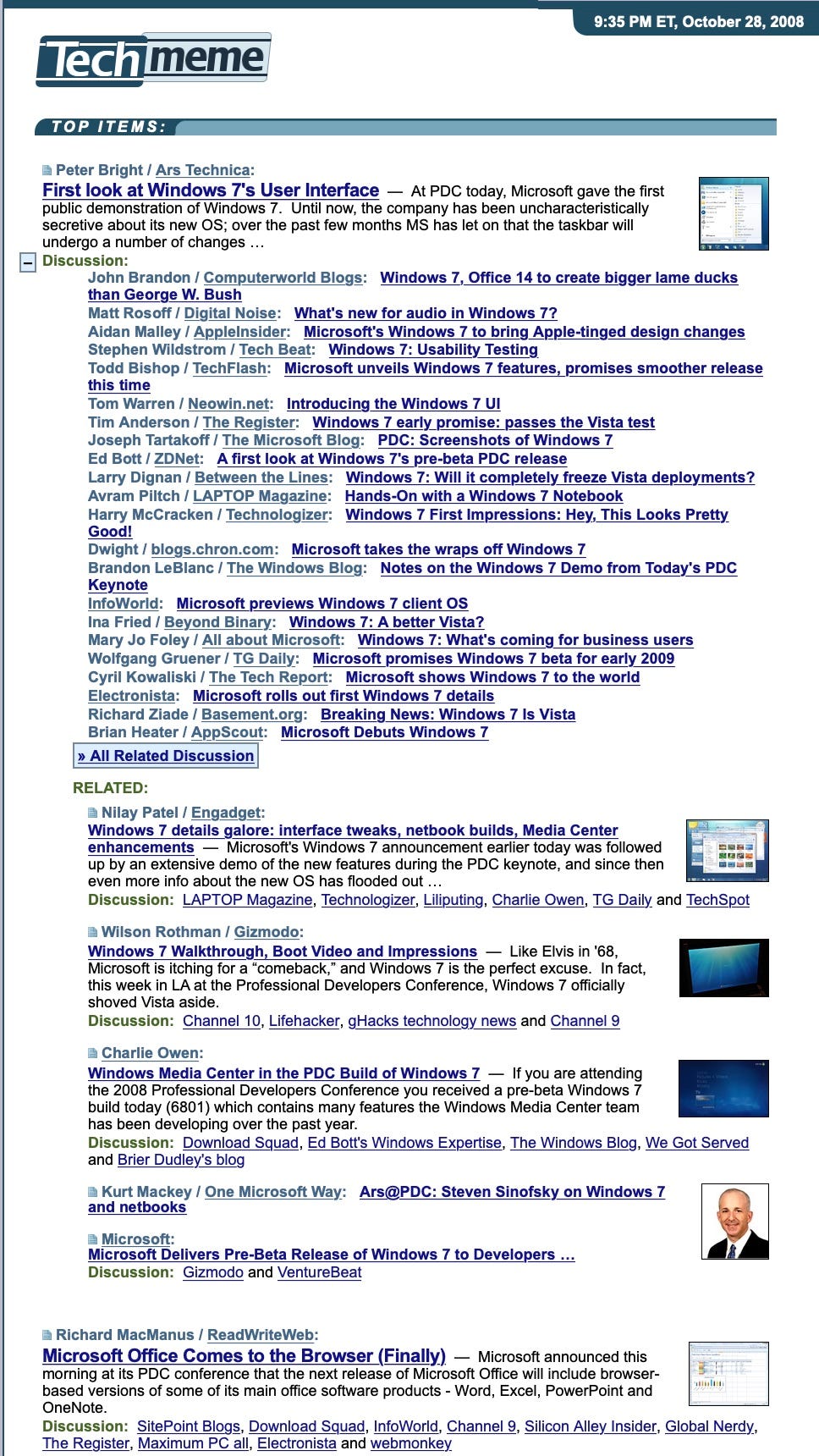
An example of the coverage was ActiveWin, a Windows-focused outlet, that wrote over 13,500 words plus screen shots on the pre-release. Andre Da Costa wrote the piece, releasing it on October 31 as the conference ended. They dove into seemingly every detail, even including their summary of the key goals of the release:5
Key Goals:
Under-promise and over deliver
Reduce Compatibility problems and bring investments in Vista forward
Reduce disk foot print and memory foot print
Improve performance
Secure, predictable
Make the Windows and PC Experience easier
Exceptional hardware and software support
Bring future releases to market faster
Personalized experience that defines you
Superior mobility through reliable performance, power management
ActiveWin concluded better than anything we could have written ourselves. Promise and deliver.:
It’s safe to say I am overwhelmed, overjoyed and most of all excited about Windows 7. This is the release of Windows everybody has been waiting for, it’s what Vista was meant to be and beyond that. Windows 7 puts the user first; it’s about going back to the fundamentals of what an operating system must do. Managing and maintaining your PC is exceptionally seamless in Windows 7 and users will appreciate the tremendous improvements and advancements this update will offer on both existing and new hardware form factors in the future. Windows Vista set the foundation for a lot of what is happening in Windows 7 today. Windows 7 makes security Essential, but not aggressive like Windows Vista. The improved UAC will no doubt give consumers confidence in this feature, just the fact that you can tweak it to a certain degree is a welcome change. Businesses will appreciate the improvements to how the OS is managed and deployed while mobile users can get better experiences between their work and home environments. Home Networking has finally reached a level of ease of use that will make even the novice to make those PCs in the home talk to each other. There is still a lot of work to be done as this early glimpse shows. But Microsoft is on the right path with Windows 7, focusing on ease of use, compatibility, better ways of interacting with the PC and managing the personal data. This is an upgrade I am looking forward to and you should too.
Posts on Windows 7 experiences across all sorts of different hardware appeared. Engadget, everyone’s favorite tech blog, tried Windows 7 on an ASUS EeePC writing “just as Microsoft demonstrated, the relatively lightweight Microsoft OS required just 485MB of RAM when Windows 7 was fully loaded, sans applications of course. Hot.”6 The article’s title was even great for all the work the team put into this specific metric, “Lightweight Windows 7 pre-Beta on Eee PC 1000H looks very promising.” I can personally confirm that memory usage number.
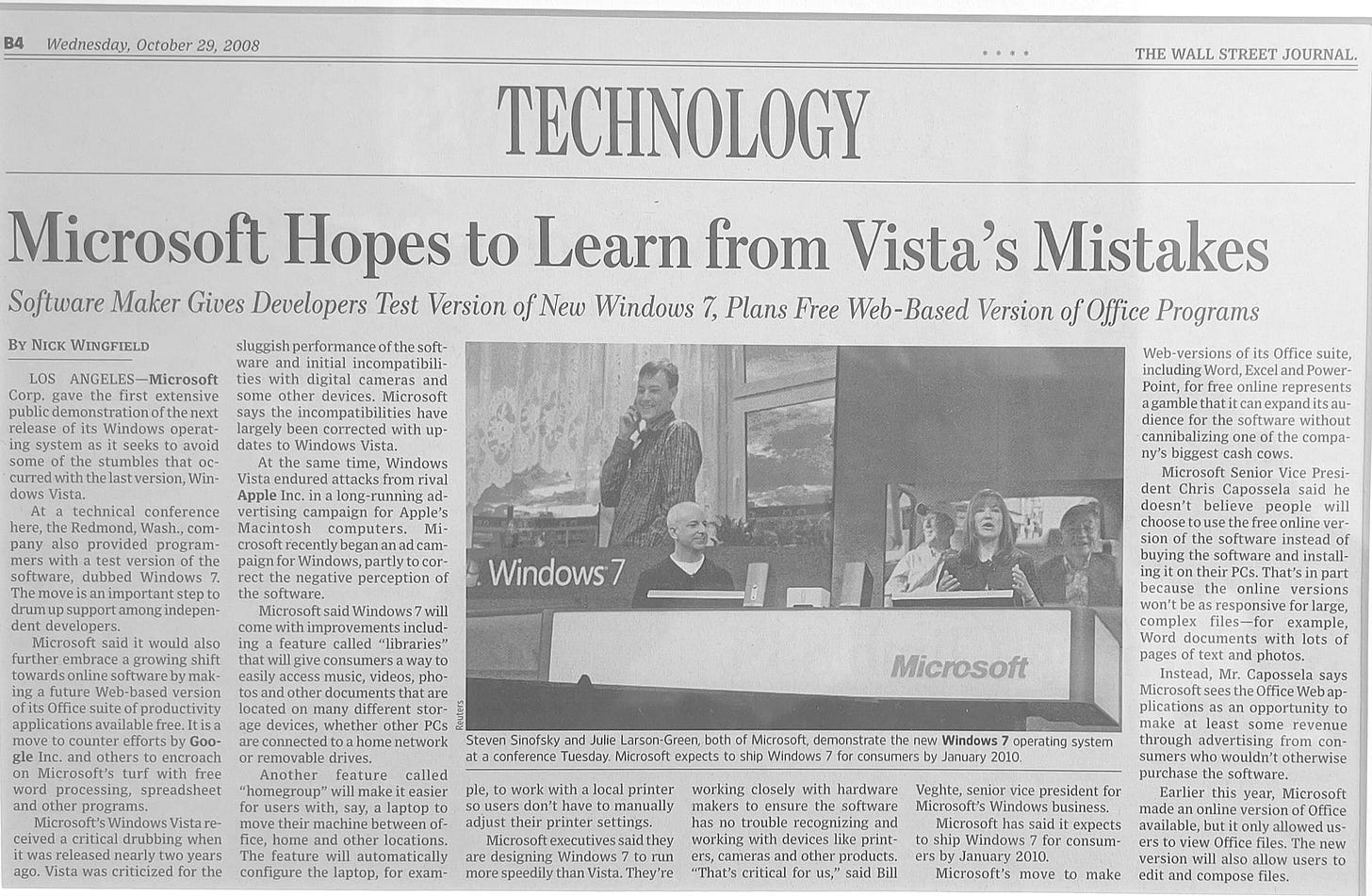
As a manager of a giant product and team there are, honestly, few truly rewarding moments that are also deeply personal. Nearly all the time there’s worry about how the team is doing and if they are finding the joy they deserve. October 28, 2008 was one of those exceedingly rare moments for me.
On to RTM…
On to 096. Ultraseven (Launching Windows 7)
There is no permalink or cached version but these stories contain the full text. https://www.techmeme.com/071017/p57#a071017p57
Via Tidbits (https://tidbits.com/2007/10/17/steve-jobss-iphone-sdk-letter/)
“A fresh take on the browser” Sept 1, 2008. https://googleblog.blogspot.com/2008/09/fresh-take-on-browser.html
Transcript of Day 2 keynote from the Professional Developers Conference via Microsoft, https://news.microsoft.com/speeches/executive-keynotes-day-2-microsoft-2008/
ActiveWin “Windows 7” October http://activewin.com/reviews/previews/windows7/ via archive.org
“Lightweight Windows 7 pre-Beta on Eee PC 1000H looks very promising”, Engadget, Oct 31, 2008. https://www.engadget.com/2008-10-31-lightweight-windows-7-pre-beta-loaded-onto-eee-pc-1000h-with-ver.html



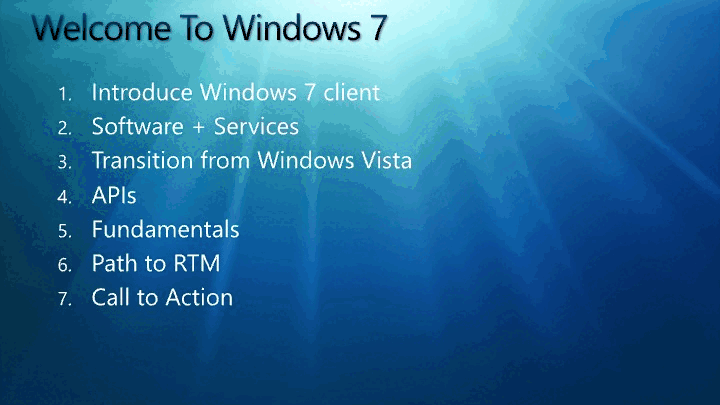
Everyone of a certain age who leads the worldwide shipment of software sings this Johnny Nash song, every time they do it
FYI, something seems to be off with the PDF of the E7 blog. Chrome, Edge, & Firefox read it very well, but Acrobat can't read most of the pages, tested on both Windows & Mac.